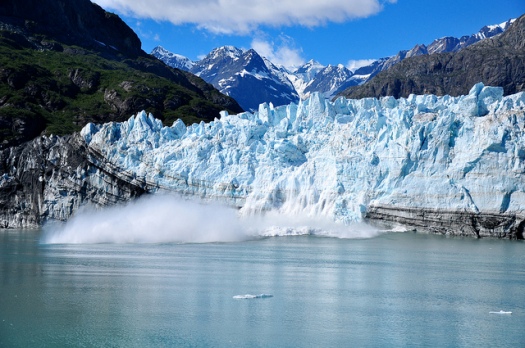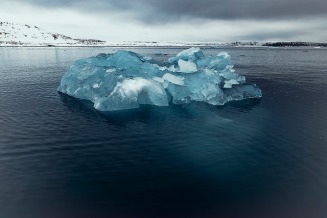Solar Power Nerdiness and the Terrifying Problem of Albedo...
 On a winter’s afternoon, however, that hill is our friend. The direction of our roofline means that we lose the afternoon sun much earlier than we would like. Fortunately, the geography is in our favor. When the hill is covered with snow, it reflects enough sunlight back onto our panels
On a winter’s afternoon, however, that hill is our friend. The direction of our roofline means that we lose the afternoon sun much earlier than we would like. Fortunately, the geography is in our favor. When the hill is covered with snow, it reflects enough sunlight back onto our panels
 Albedo matters for our comfort level within cities but it matters a whole lot more when it is scaled up to the level of glaciers and ice caps. Lose a lot of ice from the poles and you have lost a whole lot of your ability to reflect heat back up into space. To make matters worse, in the Arctic, the ice is being replaced with the relatively dark colored ocean.
Albedo matters for our comfort level within cities but it matters a whole lot more when it is scaled up to the level of glaciers and ice caps. Lose a lot of ice from the poles and you have lost a whole lot of your ability to reflect heat back up into space. To make matters worse, in the Arctic, the ice is being replaced with the relatively dark colored ocean.
 More ambitious than both of these are proposals to begin “Polar Geoengineering.” This means enhancing the albedo of polar regions in an effort to stabilize ice loss. A session at the American Geophysical Union’s annual conference last December was devoted to a number of these schemes. Suggestions include spraying seawater onto the thinning ice in wintertime using wind powered pumps, building giant underwater dams to keep out warm water at the tip of some of the world’s most important tidewater glaciers in Antarctica, and spreading reflective materials on arctic ice to stave off the sun as temperatures warm.
More ambitious than both of these are proposals to begin “Polar Geoengineering.” This means enhancing the albedo of polar regions in an effort to stabilize ice loss. A session at the American Geophysical Union’s annual conference last December was devoted to a number of these schemes. Suggestions include spraying seawater onto the thinning ice in wintertime using wind powered pumps, building giant underwater dams to keep out warm water at the tip of some of the world’s most important tidewater glaciers in Antarctica, and spreading reflective materials on arctic ice to stave off the sun as temperatures warm.
When someone who cares about climate change gets solar panels on their roof, the temptation to keep looking at how much energy you are generating is virtually irresistible. After a long and dark “La Nina” winter in Montana, the first bright days of spring have lit those panels up. The wires are humming. It is exciting to think of all the free and clean electrons now coursing through our house.
Thinking about electrons, it turns out, can also generate some terrifying thoughts about albedo.
The first bright day in March was deeply satisfying. We exceeded by 27% our energy production from the best day last October, the month the panels first went up. ...Our panels look almost directly at a 2000 foot hill at the edge of town. The hill means it takes a little longer for sunlight to reach the panels in the morning. (Living in a mountain town, you have to work with what you have got!)
 On a winter’s afternoon, however, that hill is our friend. The direction of our roofline means that we lose the afternoon sun much earlier than we would like. Fortunately, the geography is in our favor. When the hill is covered with snow, it reflects enough sunlight back onto our panels
On a winter’s afternoon, however, that hill is our friend. The direction of our roofline means that we lose the afternoon sun much earlier than we would like. Fortunately, the geography is in our favor. When the hill is covered with snow, it reflects enough sunlight back onto our panels
This nerdiness about our panels got me thinking about albedo.
Albedo is a measure of the reflectivity of a surface. Generally speaking, the lighter the color of a surface the more energy it reflects. The darker the color, the more energy it absorbs. This is why many municipalities in hot climates recommend light-colored roof shingles. The lighter color reflects heat off the roof and cuts down on the amount of cooling a house needs. On the other end of the spectrum, think about how warm a black road surface becomes on a hot day.
 Albedo matters for our comfort level within cities but it matters a whole lot more when it is scaled up to the level of glaciers and ice caps. Lose a lot of ice from the poles and you have lost a whole lot of your ability to reflect heat back up into space. To make matters worse, in the Arctic, the ice is being replaced with the relatively dark colored ocean.
Albedo matters for our comfort level within cities but it matters a whole lot more when it is scaled up to the level of glaciers and ice caps. Lose a lot of ice from the poles and you have lost a whole lot of your ability to reflect heat back up into space. To make matters worse, in the Arctic, the ice is being replaced with the relatively dark colored ocean.
This is one of the feedback loops that makes today’s unfolding of climate change so worrying. A similar feedback mechanism exists on land. If snowfall decreases in the northern boreal forests, the white of the snow sitting on the trees is replaced by the dark color of the conifers’ needles and limbs. These absorb far more of the incoming solar energy than the snow. For the same reasons, the loss of glaciers in the mountains create hotter rocks and more evaporation of the water that remains.
It is not just that the planet is warming due to the presence of greenhouse gases in the atmosphere. As it warms, the rate of warming is likely to increase due to the feedback loops that plague the thermodynamics of the climate system.
As a response to these sorts of threats, the discussion of using reflective surfaces to slow down climate warming has recently picked up steam. As mentioned in a previous post, residents of some alpine environments have already taken matters into their own hands. In Switzerland, the Rhône Glacier is now regularly covered with white fleece during the summer as a defense against the heat. Thinking along the same lines, Peruvian villagers have been whitewashing the rocks where glaciers used to sit to help preserve water for the growing season.
 More ambitious than both of these are proposals to begin “Polar Geoengineering.” This means enhancing the albedo of polar regions in an effort to stabilize ice loss. A session at the American Geophysical Union’s annual conference last December was devoted to a number of these schemes. Suggestions include spraying seawater onto the thinning ice in wintertime using wind powered pumps, building giant underwater dams to keep out warm water at the tip of some of the world’s most important tidewater glaciers in Antarctica, and spreading reflective materials on arctic ice to stave off the sun as temperatures warm.
More ambitious than both of these are proposals to begin “Polar Geoengineering.” This means enhancing the albedo of polar regions in an effort to stabilize ice loss. A session at the American Geophysical Union’s annual conference last December was devoted to a number of these schemes. Suggestions include spraying seawater onto the thinning ice in wintertime using wind powered pumps, building giant underwater dams to keep out warm water at the tip of some of the world’s most important tidewater glaciers in Antarctica, and spreading reflective materials on arctic ice to stave off the sun as temperatures warm.
All of these proposals are highly speculative. Many of them would involve substantial investments in infrastructure. None of them would solve the root problem of warming temperatures. They might, their advocates suggest, provide some stop-gap relief while something serious is done about greenhouse gases. Albedo, they point out, is a big deal.
To me, the idea of messing with the ice in polar regions borders on the ridiculous. The lesson about the reflectivity of the nearby hillside, however, has made me realize how devastating these feedback loops might be. Losing a lot of snow and ice made a substantial difference to my solar panels. One can only imagine what losing a lot of polar ice is going to mean for the planet as a whole.
It is not as if we needed another argument to reduce greenhouse gas emissions substantially and rapidly. But if you want one, just remember how important it is to keep the planet’s albedo high..
Christopher J. Preston is at various times a professor of philosophy, a commercial fisherman, a gardener, an author, and a student of powerful emerging technologies.
The most inflated title he ever possessed was Distinguished Visiting Fellow in the Ethics of the Anthropocene.
Christopher J. Preston is at various times a professor of philosophy, a commercial fisherman, a gardener, an author, and a student of powerful emerging technologies.
The most inflated title he ever possessed was Distinguished Visiting Fellow in the Ethics of the Anthropocene.

